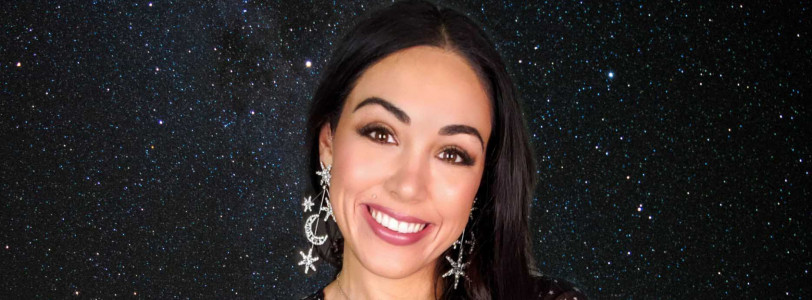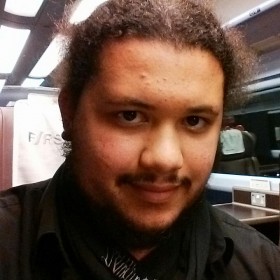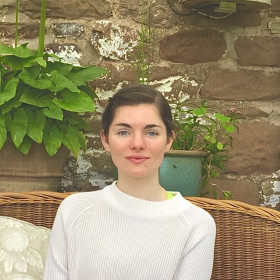Could you please introduce yourself to the reader?
Hi, I’m Kellie Gerardi. I'm coming up on 10 years in the commercial spaceflight industry, I held roles in policy, media, business development and operations, and it's been a wild ride.
I'm also a citizen scientist – I test spacesuits and NASA-supported research in microgravity with the International Institute of Astronautical Sciences. I've had the privilege to build a large science communication platform on social media and my through my book, “Not Necessarily Rocket Science: a Beginner’s Guide to Life in the Space Age”, where I drive home that our next giant leap will require the contributions of artists, engineers, and everyone in between.
You have had quite a non-conventional career path to becoming a spaceflight industry professional. Could you talk us through that journey? Was space always a passion or was it late discovery?
I grew up in Jupiter FL (very on brand). I remember my northeast bedroom window perfectly framed the stretch of sky over Cape Canaveral — I saw a lot of Space Shuttle flights from that window. So from a young age, you could say I had front row seats to the final frontier. I understood that people were living and working in space, but it took me a lot longer to realize I could be a part of that.
My career in the commercial spaceflight industry first launched in 2012. I unfortunately only discovered I loved space AFTER college and armed with a liberal arts degree, I committed myself to breaking into the space industry. Over the years I held roles in policy, media, business development, operations— it's been a wild ride. But my favorite thing – and the biggest privilege – has been my role as a crew member of Project PoSSUM, a suborbital research group, where I have the opportunity to fly weightless during parabolic research flights, evaluating commercial spacesuits and conducting scientific research in zero gravity!
I've had the privilege to build a large science communication platform on social media as well, and I recently celebrated the release of my first book: “Not Necessarily Rocket Science: a Beginner’s Guide to Life in the Space Age” - where I drive home that ALL of us can play a part in space exploration.
You have previously worked on testing space suits in microgravity. Can you tell us about that experience? What was going through your head at different stages of the tests?
In partnership with the Canadian National Research Council (CNRC), I've flown onboard a series of microgravity research flights as both a payload specialist and human test subject. To simulate microgravity and create a near-weightless research environment, an aircraft plans a parabolic flight profile not unlike a roller coaster. You can imagine an aircraft pulling up and delivering those "eyeballs in" positive g-forces, leveling out briefly at the top of the parabola, and then pushing gently over the top of that curve, easing into a 25 or 30 second-long freefall where everything in the aircraft is weightless. This arc is repeated over and over again throughout the flight, allowing researchers and their experiments precious minutes in the environment of microgravity. By adjusting the steepness of the parabola, pilots can also create reduced gravity environments to mimic the sensation of lunar (one sixth) or Martian (one third) gravitational forces.
To experience weightlessness, free from the effects of gravity, is a peculiar feeling. Imagine floating in the pool, limbs suspended and relaxed. Subtract the sensation of water beneath you and you'll have a rough idea of what you could expect to feel in microgravity. For those with sensitive stomachs, though, it can be much less serene. While the downward curve doesn't produce the same stomach drop as a rollercoaster, NASA astronaut candidates dubbed their training aircraft the "Vomit Comet," a reference to the disorientation and nausea some folks experience, also known as space motion sickness. While I've never experienced anything but joy in microgravity, I've certainly been on research flights with sick crewmates, and it seems incredibly unpleasant. A low-tech solution prevents the detritus from spewing across the cabin; Velcroed to the wall near everyone's seat is a small paper bag not unlike one you might find in the seatback pocket of a commercial aircraft.
I did a lot of fun research – shortly before one flight, I swallowed a tiny experiment from the Canadian National Research Council, a pill-shaped Bluetooth device designed to track my visceral core body temperature in flight. Once digested, I was able to "connect" the pill in my stomach with a small handheld tablet to track my vitals in real-time. For at least fifteen minutes I amused myself with pairing and unpairing my body to the device, congratulating myself on having been born in such an age where this kind of human-computer interface was possible. For the next few days, I was instructed to wear a bright yellow medical bracelet warning emergency service personnel that I was temporarily ineligible for an MRI. Welcome to the future, folks.
After experiencing microgravity, and more broadly being engrossed in the world of extraterrestrial ambition, have you found any of your perspective or world views challenged or changed?
Diversity, Equity, Inclusion. After a decade of whiteboards and war rooms, I’ve learned that the people designing technology hold the power to influence how it’s applied. In high-tech, high-stakes industries like aerospace and defense, it’s in everyone’s best interest to cultivate the broadest possible set of perspectives and novel approaches to complex problems.
To put it into perspective: when we talk about space exploration and space settlement, we’re really discussing the future of the human species – so the impacts of racial and gender inequities are profound and far-reaching. The stakes are too high for any single demographic to steer the entirety of Spaceship Earth.
We’ve come a long way but still have a long way to go: if the space industry wants the world’s trust and support in this quest to open the final frontier for the benefit of all of humanity, then our workforce needs to more fully represent humanity. We need to hold our peers and leaders accountable for prioritizing it.
I care so deeply about representation, especially as it relates to women in STEM, and that it makes it all the more surreal to see my own book climb Amazon's Best Sellers lists in Space & Science categories – where male authors and narratives are often the norm. I am overwhelmed and SO grateful for everyone's support. Space is for everyone, and it means the world to have the opportunity to share how anyone can contribute to humanity's next giant leap, and that it's Not Necessarily Rocket Science.
What has been the highlight of your career to date?
Definitely connecting with fans – I’ve made more than 500K friends on social media, and some of those people have told me they’ve gone back to school, applied for dream jobs, started SciComm platforms, etc. because they were inspired by my encouragement. That means the world.
Another highlight was having the privilege to know Stephen Hawking. It was such a joy to know him, and to witness not only his brilliance but also his great humor and mischief. At his 75th birthday party, I remember thinking how his diverse group of friends really summed up a life well-lived. He left his thumbprint on the entire world, and humanity is better off because of it. It was a life’s honor to contribute a short chapter to his and his brilliant daughter Lucy’s children’s book, “George and the Blue Moon” – I highly recommend the series for young book shelves.
And what has been most challenging?
This industry wasn't an obvious fit for me, for many reasons. First, coming from an arts background, my path was really non-traditional. It’s that feeling like you have to work twice as hard to prove yourself - and this enormous feeling of pressure that if you mess up, it’s not just a reflection on you, it’s somehow a reflection on all women in space or all non-engineers.
Second, I didn't see a lot of people who looked like me. I loved makeup and fashion and early on, I was extremely self-conscious and overly concerned with how I might be perceived, so I remember toning down my love of those things out of fear that people might take me less seriously because of it.
You also work as a science communicator, making science accessible and understandable to people across the world. How do you approach that task, and what are some of the challenges in breaking down jargon?
I've had the privilege to build a large science communication platform, starting with social media like Instagram and TikTok and then having the opportunity to take the conversation onto bookshelves with the release of my book at the end of last year.
Once I discovered my passion for space exploration, sharing that passion with the public came easily to me. In some ways, my lack of a traditional engineering degree amplified my space communication skills; I naturally gravitated away from nitty-gritty technical concepts in favor of the big picture takeaways that had gripped me in the first place, easily distilling the themes that resonated most strongly with the general public.
I was neither a poet nor a brilliant engineer, but I was an earnest space advocate, an active contributor to scientific research, and a natural communicator. In spreading awareness of the future we could collectively unlock, I dreamed of motivating people to make the most of life in a Space Age. Luckily for me, reaching thousands of people became a whole lot easier with the birth of social media.
You have a strong social media presence, and are a gateway into a field that is widely adored but nearly wholly inaccessible to the public. Does that influence how you approach your posts?
The most effective scientists are capable of communicating not only data and results but also human impact – the story of the data – to the public. That’s how we spark curiosity, popularize a field, or inform public policy. In addition to entertaining and inspiring, science communication can also play an important role in increasing the public understanding of science – and scientific literacy is a cloak of protection for modern societies.
Space is ubiquitous – no more than sixty miles away from every single person on Earth. So how to bring space down to Earthlings in a way that captures hearts and imaginations? If we want an emotionally invested public, we must bridge the gap between science and society, the ultimate quest of science communicators.
You published a book titled ‘Not Necessarily Rocket Science: A Beginner's Guide to Life in the Space Age’. Could you tell us about the book, and what a reader might expect?
In the introduction to NNRS, I draw comparisons to the Renaissance: art was only one manifestation of a new way of thinking. Cultural innovation was also happening across the very different disciplines of medicine, technology, religion, politics, philosophy, science, and even warfare.
Similarly, engineering innovation represents just one small slice of the Space Age. This is a broader cultural movement, and our next giant leap will require the contributions of artists, engineers, and everyone in between. We have architects to design space habitats and stations, but we also need designers who can turn them into homes away from Earth. For every scientist, we need artists who can inspire, journalists who can report, and educators who can mold the next generation of students into adults who are motivated and capable of contributing to their own future.
For the first few hundred humans to venture into space, the spaceflight focused entirely on function. But for the next few hundred humans to travel to space, we have the opportunity to optimize on experience. The next wave of space travelers won't all be engineers, and that's entirely the point. We all have a role to play and there’s a place in this industry for anyone who’s passionate about advancing humanity’s footprint in the solar system!
You are a big proponent for the democratisation of space access. What does a democratic space industry look like to you?
If we’re aiming to survive as a species in the long-term, then small, elite groups of hand-selected, highly trained astronauts aren’t going to cut it, no matter how diverse their crews are. We need to approach the problem with a more universal goal in mind: democratizing access to space for humans of all backgrounds and abilities —regular people like you and me.
It’s really exciting to see the suborbital space industry taking that approach as a business strategy. Folks who can afford Virgin Galactic tickets are likely to be a bit older and have more diverse medical histories than your average astronaut, so they’ve had to design their operation with that diverse health history in mind.
That’s what it means to democratize access to space - designed not for the elite, but for the broadest possible swaths of the human population. We're on the cusp of a paradigm shift that will democratize access to space and enable the wildest dreams of everyday people like you and me.
This is why I sought out a career in the commercial space industry a decade ago. This is the future I wanted to help enable. And it's the exact vision and dream I've held on to while working to pave my own path to space through suborbital research. Space is for everyone, and this is just the very beginning of humanity's next chapter. Ad Astra!
If presented the opportunity to leave Earth and go to live on Mars, would you take it?
In a heartbeat!
If you could send a message to 16-year old Kellie, what would you say?
Don’t let anyone assign a ceiling to your dreams!
Where can people find out more about your work?
You can find me on all social media platforms @kelliegerardi!
Is there anything else you’d like to add?
For me, space represents the best of humanity – the spirit of exploration, the genius of innovation, the quest for knowledge, and this overwhelming hope that we can survive our time so that the next generation can live in the future.
I feel so lucky to have been born in this window of history – the first time in 4.5 billion years that life on Earth has been able to reach space. It's a window of opportunity that we have to seize, because we don't know how long it will be open.










this is SO EXCITING! I am thrilled they will be needing artists in the future of space 💁🏻♀️, and that representation is seemingly a priority - one often thinks of the people in charge of space travel to be either really militant government type blokes or bajillionaires with little concern for how the developments relate to the rest of humanity - that's often the assumption, its genuinely so uplifting and encouraging to learn that this is not at all the case.
What an inspiring woman.